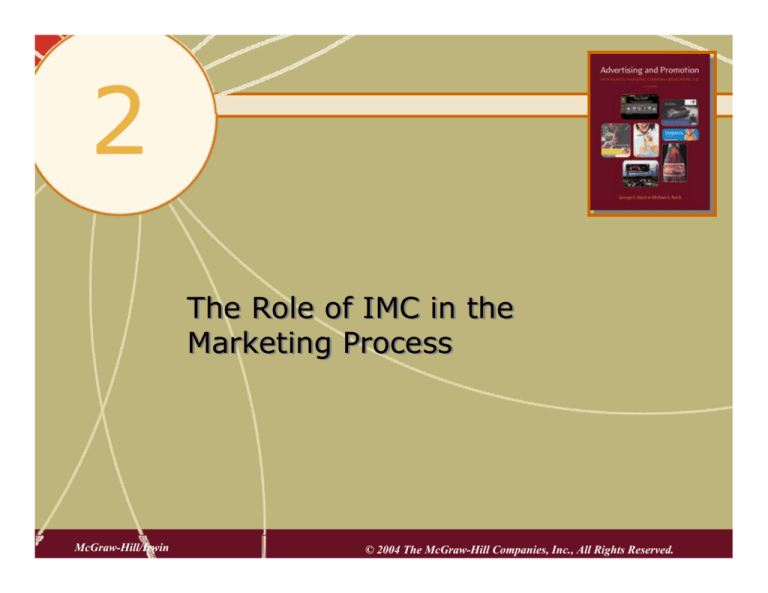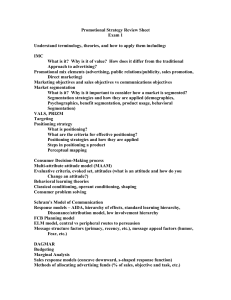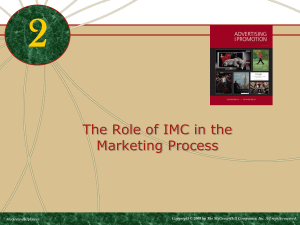
2
2
The Role of IMC in the
Marketing Process
McGraw-Hill/Irwin
© 2004 The McGraw-Hill Companies, Inc., All Rights Reserved.
Marketing and Promotions Process Model
Marketing
Strategy and
Analysis
Target
Marketing
Process
Identifying
markets
Competitive
analysis
Target
marketing
Market
segmentation
Selecting
a target
market
Positioning
through
marketing
strategies
Marketing Planning
Program Development
Product
decisions
Pricing
decisions
Channel of
distribution
decisions
Promotional
decisions
•advertising
•direct
marketing
•internet/
interactive
marketing
•sales
promotion
•publicity
and public
relations
•personal
selling
Target Market
Promotion to
final buyer
Promotion
to trade
Resellers
Purchase
Ultimate
customer
•Consumers
•Businesses
The Target Marketing Process
Identify markets with unfulfilled needs
Determining market segmentation
Selecting market to target
Positioning through marketing strategies
Five-Step Segmentation Process
1.
2.
3.
4.
5.
Finding ways to group consumers
according to their needs.
Finding ways to group marketing actions,
usually the products offered, available to
the organization.
Developing a market/product grid to
relate the market segments to the firm’s
products and actions.
Selecting the product segments toward
which the firm directs its marketing
actions.
Taking marketing actions to reach target
segments.
Bases for Segmentation
• Geographic Segmentation
– State - region - country - climate
• Demographic Segmentation
– Age, sex, income, education, occupation,
social class
• Psychographic Segmentation
– AIOs, (Activities, Interests, Opinions)
– VALS (Values and Lifestyles)
– Personality traits
• Behavioristic Segmentation
– Usage, loyalties, occasions.
• Benefit Segmentation
– Types of specific needs or wants to be
satisfied.
Selecting a Target Market
Determining How Many Segments To Enter
¾
Undifferentiated Marketing – offering one product or
service to the entire market
¾
Differentiated marketing – competing in a number of
segments with separate marketing strategies for each
¾
Concentrated Marketing – focusing on one market
segment
Determining Which Market Segments
Offer the Most Potential
¾ Determine sales potential of the segment
¾ Determine opportunities for growth of the
market segment
¾ Analyze the competition in the segment
¾ Analyze the company’s ability to compete in
the market segment
¾ Decide how to compete in the market segment
Segmentation Decision Check List
¾ Can the size of the market
segment be measured?
¾ Is the market segment large and
profitable enough to serve?
¾ Is the segment identified
accessible? Can it be reached
effectively and efficiently?
¾ Can effective marketing programs
be developed to attract and serve
the segment identified?
The Positioning Process
Positioning Concept
The desired perception or
association management wants
target customers to have for a
firm and/or its products
Positioning Strategy
Positioning Effectiveness
The extent to which management’s
positioning objectives are achieved
in the market target
Market
Target
Positioning of the brand
The positioning of the brand by
the buyers in the market target
The combination of marketing
actions used to portray the
positioning concept to targeted
buyers
JetBlue Airways positions itself as a low price
airline with great service
Positioning Strategy Development Process
1.
Identify the competitors
2.
Assess perceptions of them
3.
Determine their positions
4.
Analyze consumer preferences
5.
Make the positioning decision
6.
Monitor the position
Product/Service and Brand Positioning
BASIC QUESTIONS TO ASK
1. What position, if any do we currently hold in the mind
of customers?
2. What position do we want to hold?
3. Whom do we have to compete against to establish this
position?
4. Do we have the resources to occupy and hold the
position?
5. Can we stay with one consistent positioning strategy?
6. Does our marketing and advertising match our
positioning strategy?
Approaches to Positioning A Product/Service
or Brand
1.
By Product or Service Attributes and
Benefits
2.
By Price/Quality
3.
By Use or Application
4.
By Product Class
5.
By Product or Service User
6.
By competition
7.
By cultural symbols
Positioning by cultural symbol
Source: Courtesy The Pillsbury Company
Product Decisions
AA product
product is
is aa bundle
bundle of
of benefits
benefits or
or values
values that
that
satisfies
satisfies the
the needs
needs of
of consumers
consumers
¾ Product symbolism refers to what a product or
brand means to customers
¾ Product quality, branding, packaging, and
company name contribute to product image
¾ Branding:
– Brand name communicates attributes and meaning
– Advertising creates and maintains brand equity which
results from the image and/or impression of a brand
The Value of Strong Corporate and/or
Brand Identity
Strong corporate/brand equity:
¾ Creates more options for competing against
lower-priced competitors
¾ Builds customer loyalty
¾ Makes it easier to withstand economic
fluctuations and marketing crises
¾ Allows companies to sell products/services at a
premium price and maintain larger profit
margins
¾ Can facilitate brand and line extensions
¾ Makes customer response more inelastic to
price increases and elastic to price decreases
Crest uses its strong brand equity to launch
a line extension
Packaging
¾Traditional functions of packaging:
economy, protection, storage
¾ Packaging has become increasingly
important because:
self service emphasis of many stores
buying decisions made at point-ofpurchase
often customers first exposure to product
¾Packaging is a way to communicate
to consumers
Arm & Hammer Promotes New Packaging
Source: Courtesy Church & Dwight Co., Inc.
Pricing Decisions
¾ Price must be consistent with perceptions of
the product
¾ Higher prices communicate higher product
quality
¾ Lower prices often reflect bargain or “value”
perceptions
¾ A product positioned as high quality while
carrying a lower price than competitors may
confuse customers
¾ Price, advertising and distribution must be
unified to create the position for the product or
service.
Distribution Channel Decisions
Channel decisions involve:
¾ Determining the type of channel system:
– Direct channels
– Indirect channels
¾ Selecting, managing and motivating
marketing intermediaries such as
–
–
–
–
Wholesalers
Distributors
Brokers
Retailers
Push Versus Pull
Push Policy
Pull Policy
Producer
Producer
Producer
Producer
Wholesaler
Wholesaler
Wholesaler
Wholesaler
Retailer
Retailer
Retailer
Retailer
Consumer
Consumer
Consumer
Consumer
Information Flow
"Push" Techniques
¾ Point of sale displays, racks, stands
¾ Trade deals, special displays
¾ Dealer premiums, prizes, gifts
¾ Cooperative advertising deals
¾ Advertising materials, mats, inserts
¾ Push money or "spiffs"
¾ Collaterals, catalogs, manuals
¾ Trade shows, conventions, meetings
"Pull" Techniques
¾ Sampling, free trial
¾ Coupons
¾ Premiums or gifts
¾ Contests, sweepstakes
¾ Price-off deals
¾ Refunds/rebates
¾ Frequency/loyalty programs
¾ Point-of-purchase advertising
Premium offers are part of a pull strategy
Source: KELLOGG’S CORN FLAKES® is a trademark of Kellogg
Company. All rights reserved. Used with permission.








